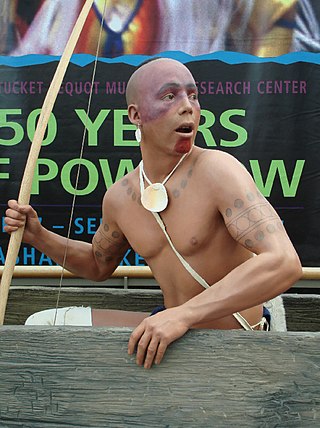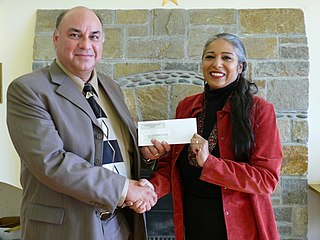Related Research Articles

The Pequot are a Native American people of Connecticut. The modern Pequot are members of the federally recognized Mashantucket Pequot Tribe, four other state-recognized groups in Connecticut including the Eastern Pequot Tribal Nation, or the Brothertown Indians of Wisconsin. They historically spoke Pequot, a dialect of the Mohegan-Pequot language, which became extinct by the early 20th century. Some tribal members are undertaking revival efforts.

Mashpee is a town in Barnstable County, Massachusetts, United States, on Cape Cod. The population was 15,060 as of 2020. The town is the site of the headquarters and most members of the Mashpee Wampanoag Tribe, one of two federally recognized Wampanoag groups.

King Philip's War was an armed conflict in 1675–1676 between a group of indigenous peoples of the Northeastern Woodlands against the English New England Colonies and their indigenous allies. The war is named for Metacom, the Pokanoket chief and sachem of the Wampanoag who adopted the English name Philip because of the friendly relations between his father Massasoit and the Plymouth Colony. The war continued in the most northern reaches of New England until the signing of the Treaty of Casco Bay on April 12, 1678.

The Wampanoag, also rendered Wôpanâak, are a Native American people of the Northeastern Woodlands currently based in southeastern Massachusetts and formerly parts of eastern Rhode Island. Their historical territory includes the islands of Martha's Vineyard and Nantucket.

The Massachusett language is an Algonquian language of the Algic language family that was formerly spoken by several peoples of eastern coastal and southeastern Massachusetts. In its revived form, it is spoken in four Wampanoag communities. The language is also known as Natick or Wôpanâak (Wampanoag), and historically as Pokanoket, Indian or Nonantum.

Iḷisaġvik College is a public tribal land-grant community college in Utqiaġvik, Alaska. Operated by the North Slope Borough, a home rule government of the Iñupiat, it is the only tribally controlled college in Alaska, and it is the northernmost accredited community college in the United States. The college is located within the boundaries of the North Slope. It is an 89,000-square-mile (230,000 km2) region of Arctic tundra. It is connected to the 414-mile (666 km) Dalton Highway only during the winter, by an ice road for local residents. The community can also be reached by plane.
Praying Indian is a 17th-century term referring to Native Americans of New England, New York, Ontario, and Quebec who converted to Christianity either voluntarily or involuntarily. Many groups are referred to by the term, but it is more commonly used for tribes that were organized into villages. The villages were known as praying towns and were established by missionaries such as the Puritan leader John Eliot and Jesuit missionaries who established the St. Regis and Kahnawake and the missions among the Huron in western Ontario.

William Apess, was a Methodist minister, writer, and activist of mixed-race descent. Apess spent most of his career in New England.

Mildred "Millie" Noble was an American writer and Native American activist. Noble helped to found the Boston Indian Council, which is now known as the North American Indian Center of Boston.

The Old Indian Meeting House is a historic meeting house at 410 Meetinghouse Road in Mashpee, Massachusetts. Built in 1758, the meetinghouse is the oldest Native American church in the eastern United States. The building was listed on the National Register of Historic Places in 1998.

The National Congress of American Indians (NCAI) is an American Indian and Alaska Native rights organization. It was founded in 1944 to represent the tribes and resist U.S. federal government pressure for termination of tribal rights and assimilation of their people. These were in contradiction of their treaty rights and status as sovereign entities. The organization continues to be an association of federally recognized and state-recognized Indian tribes.

Native American tribes in Massachusetts are the Native American tribes and their reservations that existed historically and those that still exist today in what is now the Commonwealth of Massachusetts. A Narragansett term for this region is Ninnimissinuok.
The Mashpee Wampanoag Tribe is one of two federally recognized tribes of Wampanoag people in Massachusetts. Recognized in 2007, they are headquartered in Mashpee on Cape Cod. The other Wampanoag tribe is the Wampanoag Tribe of Gay Head (Aquinnah) on Martha's Vineyard.
Joan Tavares Avant, also known as Granny Squannit, is an educator, Mashpee Wampanoag tribal leader, historian, and writer living in Mashpee, Massachusetts. Avant served as the Mashpee Public School Director of Indian Education and was a founding Trustee of the Wôpanâak language immersion program. As a tribal leader, Avant has served as Tribal President, Tribal Housing Commissioner, Clan Mother, and Professional Tribal Elder. Her writer's credits include a long-running column in the Mashpee Enterprise, editing the National League of American Pen Women's newsletter, and People of the First Light (2010).

Mashpee Nine: A Story of Cultural Justice is a 2016 non-fiction book by author, journalist, and activist Paula Peters, a member of the Mashpee Wampanoag Tribe. It is a companion book for the documentary, “Mashpee Nine: The Beat Goes On”. The book recounts details of a police raid, arrest and court trial of nine Wampanoag tribal members who were drumming on the Mashpee Pond campsite July 29, 1976 in Mashpee, Massachusetts.
Native American newspapers are news publications in the United States published by Native American people often for Native American audiences. The first such publication was the Cherokee Phoenix, started in 1828 by the Cherokee Nation. Although Native American people have always written for state and local newspapers, including the official publications of Native American boarding schools, periodicals produced by Native people themselves were relatively few and far between until the 20th century.
Everett Gardiner Weeden Jr., or Tall Oak, was an artist, activist, survivalist, and historian of Indigenous peoples of the Northeastern Woodlands. The Mashpee Wampanoag Tribe stated that Weeden was "a documented descendant of the Mashantucket Pequot, Narragansett, and Wampanoag tribes".
Nelson Drue Simons (1885-1953) was a Mashpee Wampanoag Tribe chief from 1916 to 1928 and government official who was also the first known Native American graduate of Suffolk University Law School in Boston.
The National Indigenous Women's Resource Center (NIWRC) is a nonprofit organization that provides health resources to Native American women and also advocates for women's health, housing, and domestic violence support. The organization was founded and is led by Native American women.
References
- ↑ "NAICOB". NAICOB.
- 1 2 Stickgold, Emma (2008-01-27). "Mildred Noble, 86; writer and Native American activist". Boston Globe . Retrieved 2008-02-15.
- ↑ Fixico, Donald (2000). The Urban Indian Experience in America. Albuquerque: U of New Mexico P. p. 114. ISBN 978-0826322166.
- ↑ Wayne, Tiffany (2010). American Women of Science. ABC-CLIO. p. 201. ISBN 978-1-59884-158-9.
- ↑ Johansen, Bruce; Pritzker, Barry (2007). Encyclopedia of American Indian History. ABL-CLIO. p. 651. ISBN 978-1851098170.
- ↑ Mills Sr., Earl (2012). Talking with the Elders of Mashpee. lulu.com. p. 123. ISBN 978-1105953392.
- ↑ Delucia, Christine M. (2018). "Protesting the "Perfect City": Reorganizing Native Memoryscapes across Greater Boston". Memory lands: King Philip's War and the place of violence in the northeast. Yale University Press. ISBN 9780300201178.
- ↑ McClinton-Temple, Jennifer; Velie, Alan (2007). Encyclopedia of American Indian Literature. Facts on File. p. 110. ISBN 978-0816056569.
- ↑ Mackenzie, Robert; Stone, Peter (2013). The Excluded Past: Archaeology in Education. New York: Routledge. p. 119.
- ↑ Deloria, Philip (1999). Playing Indian. New Haven: Yale UP. p. 1997. ISBN 978-0300080674.
- ↑ "NAICOB Grandparents' Resource Guide". naicobfamilyresources.org.